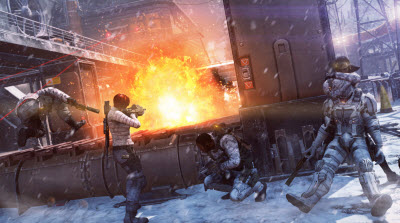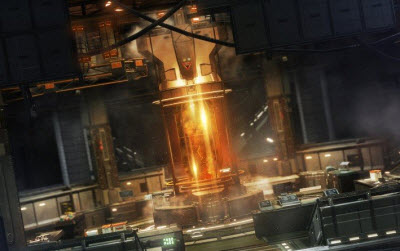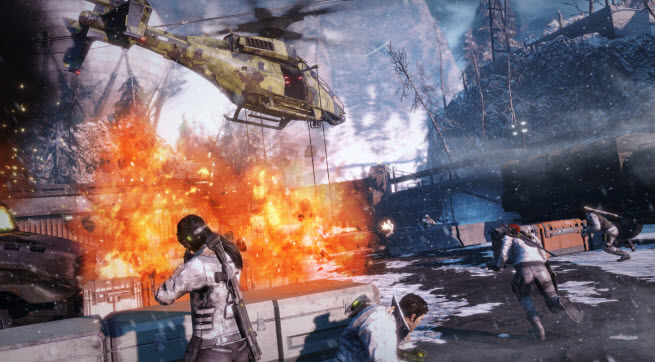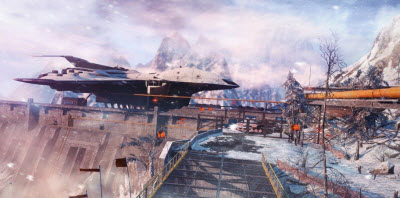Insomniac Games’ new cooperative-style sci-fi shooting game Fuse has already lit a few controversies. When Insomniac first revealed it at the E3 trade show in 2011, it was a comic title called Overstrike. But the development team did some soul-searching and decided to re-create Fuse’s tone as a serious game with intense, mature combat, akin to the fierce battles in Gears of War. The change raised hackles among fans, some of whom preferred the previous style, but it unleashes Insomniac’s developers to make the game that they want to build.
As currently conceived, Fuse is a four-player co-op game with a single-player campaign and a multiplayer version dubbed Fuse Echelon. You have to work together to take down enemies, upgrade weapons, and unlock abilities. The Overstrike 9 agents, as the characters are called, have access to upgradeable weapons powered by an alien energy dubbed Fuse, which can help them create monumental damage. I caught up with Ted Price, chief executive of Insomniac, which has a built a strong reputation on the Ratchet & Clank and Resistance franchises.
Electronic Arts is publishing the game next March, as long as Insomniac — with its 220 employees — doesn’t get the urge to tear its designs up and start over again. And this one is going to be available on multiple platforms, including the Xbox 360 and the PlayStation 3. That’s the first time years that Insomniac has moved beyond the Sony PlayStation platform to something else. I played the Echelon multiplayer version of Fuse before I interviewed Price. Here’s an edited transcript of our talk.
Ted Price: So what did you think?
GamesBeat: It’s different. It’s not something I’ve seen before. With the emphasis on four players, it seems like Left 4 Dead in some ways. But in a very different environment and setting.
Price: Yeah. One thing we were adamant about at the very beginning is making sure that it’s a great single-player experience. In fact, we weren’t showing it tonight, but you can play Echelon by yourself. You always play with four characters, so three of the characters will be bots. Same thing with the campaign. Personally, I play through the campaign in single-player all the time. I’m probably less social than some of my peers, but I also want to see how things are shaping up.
We spent a lot of time with the bots. We have a very specific philosophy when it comes to the bots. It’s been important for us to make that work. The bots have to do what you want them to do, what you expect them to do, but they can’t go crazy and steal your kills and be the kind of bots that you shake your fist and say, “I can’t believe you just ruined my moment of victory!” That’s been a constant tuning challenge for us over the last several years.
 GamesBeat: Backing up a little, tell me about the emergence of this project and where you guys left off. You’d just finished a series; were trying to come up with something new?
GamesBeat: Backing up a little, tell me about the emergence of this project and where you guys left off. You’d just finished a series; were trying to come up with something new?
Price: Well, Brian Allgeier is our creative director on Fuse. He proposed a four-player cooperative game featuring agents who infiltrate exotic locations across the globe. That was a few years ago. We latched on to that because we wanted to create a game that reflected how social gaming has become. Something that reflected the fact that gamers want to play with their friends. Consoles in particular make it very easy to get online and play with your buddies.
At the same time, we were wary of making a four-player co-op game, for two reasons. One, design metrics are tough when you have four characters in your game at all times. You have to be really careful about how you design your spaces. Second, we wanted to make sure that we weren’t ignoring the fact that a lot of players are going to want to play this game by themselves. From the very beginning, we wanted to balance those two experiences well. We’ve been spending the last few years doing that. That was the genesis, and that hasn’t changed at all — the desire to make a great four-player cooperative game and a great single-player game that runs through the same campaign and the same universe.
GamesBeat: It’s also coming at the end of a long cycle here, where people have had three games worth of Resistance, Halo, and Gears of War. It seems like you had to do something different from those as well.
Price: The pressure was even higher to do something that stood out. We’re going up against games that have mature engines, mature stories — meaning stories that have been around for a while and developed their characters — and mature gameplay philosophies. We’re coming in as the new kid on the block. We understand that we’re probably going to be judged more harshly as a result.
GamesBeat: And an original intellectual property on multiple platforms seems like a new thing for you too. Why did you go that way?
 Price: We own the IP to Fuse. That’s been important for us, because we want to be able to control where this world is going. In the long term, that’s a goal of ours as a company. As for multiplatform, going in that direction has been a desire of ours for a while. We want to reach a broader audience. We want to reach out to Xbox 360 players who asked us, over and over again, “When are you going to make a game for us?” Early on, we made the call to create new IP that is multiplatform, and build new technology and tools that support both Xbox 360 and PlayStation 3.
Price: We own the IP to Fuse. That’s been important for us, because we want to be able to control where this world is going. In the long term, that’s a goal of ours as a company. As for multiplatform, going in that direction has been a desire of ours for a while. We want to reach a broader audience. We want to reach out to Xbox 360 players who asked us, over and over again, “When are you going to make a game for us?” Early on, we made the call to create new IP that is multiplatform, and build new technology and tools that support both Xbox 360 and PlayStation 3.
Getting back to the new IP, the new universe idea, as a company we really enjoy making new universes. It’s exciting and terrifying. Exciting because you can do anything, and terrifying because you never know how it’s going to be received.
Every single universe that we’ve created has evolved significantly during production. In this case — I’ll just attack this head-on — in 2011 we released a trailer for the game made by Blur. It was great, a really good trailer. That showed the promise of the game and the style that we were heading for. Like all of our games, we continued to change the style. When we revealed the changes a year later, we got a shocked reaction from a lot of fans who had built up the game in their heads from this trailer they saw in 2011.
Now, ironically, Fuse has changed less than any other IP that we’ve built. But this has been a much more public change. I know a lot of people have had fairly strong reactions. It’s interesting, too — since we released a trailer two months ago, we’ve made major changes to the look of the game. We’ve added a lot more color. That’s been in response to fan feedback from this first new trailer that we released. I think when people see it again, they’re going to be surprised at how much it’s morphed one more time. But that’s the development process. That’s what we enjoy. That’s how we get to a final product that we’re truly proud of.
 GamesBeat: Would you call this pivoting, or do you actually sort of pivot on a daily basis?
GamesBeat: Would you call this pivoting, or do you actually sort of pivot on a daily basis?
Price: I wouldn’t say we do it on a daily basis. The decisions we make, we analyze them, we think them through, we prototype, and eventually we land on something. That happens on a gradual basis. Usually, depending on what area it is, we’ll lock something down and say, “This is not changing.” There are points in the development process where you have to do that, whether it’s tech or character design or genre. You name it. But there are other things we continue to evolve throughout.
The balance we have to strike is creating a schizophrenic personality for players. We need to create the identity that people can latch onto and get excited about. Since we’re launching in the spring of 2013, we’re at the point now where we’ve locked down who we are and what this game is. Tonight was a great chance for us to show off wha we believe is the game’s identity.
GamesBeat: Given the state of the industry right now, it does seem like a good time to go multiplatform. You almost need that room to spread out. You were on that panel at the DICE Summit last year about companies that have been around for more than two decades. That’s a long time to stay on one platform.
Price: No, I agree. And it’s not just consoles. To be fair, we haven’t been around for two decades. Not quite two decades. We’re coming up on our 19th birthday at Insomniac.
GamesBeat: Do you look at the industry with dismay right now?
Price: Not at all. The industry reflects society right now. Society is evolving extremely fast in terms of how it uses technology. Our industry is experiencing that change as well. We’ve been very lucky over the last almost two decades to have a stable, predictable industry. But now we’re in a different world. That change has come upon us and everyone else in the world in the last five years. So it’s not just us. It’s the internet. It’s sales. It’s traditional media. Everything and everybody is feeling the effects of this accelerated change in our world.
GamesBeat: The good thing, though, is that games are still getting in front of more people than ever. The number of games being played is in the billions, probably.
Price: Yeah. It’s true. What’s cool about that, and what’s cool about the change, is that you don’t have to be a multibillion-dollar corporation to have the answer, to figure out what it takes to reach that global audience. You can be a guy in his bedroom with a great idea, using off-the-shelf tools to build something that nobody’s ever seen before. That guy can change the world. That’s the promise that got me into games in the first place. I feel like, in many ways, it’s come full circle.
GamesBeat: You’ve ventured into Facebook. What did you think of that?
Price: It was a learning experience, for sure. In fact, it continues and it’s evolving. Yesterday we went into open beta on Kongregate with Outernauts. For us it’s exciting, because we learned a lot about what our players wanted when we released Outernauts on Facebook. We made a lot of big changes. Now we’ve brought a very different game, one that we think reflects those players’ desires, to Kongregate, which we think is an audience of players who appreciate the kind of game we have in Outernauts.
GamesBeat: How are you looking forward to the next generation of consoles?
Price: Well, I am looking forward to it. As a tech geek myself, I love the idea of having new and more powerful hardware. That’s something we thrive on. We’ve been a console developer for a long time. That’s exciting for us. I’m more curious to see how gamers respond, because it’s a different world. We have so many different platforms that we can experience games on today. The big question is, how are the larger console manufacturers going to address that? Have our habits changed enough to actually affect the way hardware is designed? I don’t know. We’re going to see pretty soon, I guess.
GamesBeat: What do you think about working with EA?
 Price: I may have said this earlier, but it’s been great to have events where we can show off progress with the game. We can bring together a lot of journalists from a long way away and say, “Here’s the game. Check it out.” It always will be an Insomniac. We own the intellectual property. EA is our partner and they provide great support when it comes to marketing, sales, quality assurance, localization, and distribution. That’s been what we expect from a great partner.
Price: I may have said this earlier, but it’s been great to have events where we can show off progress with the game. We can bring together a lot of journalists from a long way away and say, “Here’s the game. Check it out.” It always will be an Insomniac. We own the intellectual property. EA is our partner and they provide great support when it comes to marketing, sales, quality assurance, localization, and distribution. That’s been what we expect from a great partner.
GamesBeat: The direction that it’s going, though, does this feel like an effort that’s as large as what you might have to do for next-gen games?
Price: I don’t know yet what we have to do for next-gen. I think every product we do is a struggle between implementing efficient practices that we’ve learned from the previous project and expanding the scope to meet consumer demand. That’s a challenge. We struggled over the years with scope because we know that players are insatiable. At the same time, we know that to deliver a great game, we have to pick just one or two things and do them better than anybody else.
We’ve missed in past games. We’ve had kitchen-sink games where we do a lot of things and we do them pretty well, but we don’t do them the best. We continue to strive to deliver an experience that’s he best at something. I don’t think we’re alone in that. I’ll throw one out there as an example of somebody that’s succeeded, and that’s Minecraft. Minecraft totally threw graphics out the window. Maybe it’s a stylistic choice, but… Notch and his team did something nobody else could do and they did it better, in terms of creating this procedural world, than anybody else ever has. That’s propelled them to success, and it’s awesome.
Anyway, it comes back to controlling scope and figuring out what makes your game sing. For me, the fact that the industry does change faster and faster is what provides a lot of the fun. It provides a lot of the stress too, but it’s absolutely never boring.
 GamesBeat: Some of your peers are retiring, but it sounds like you’re ready to keep going full steam here. The BioWare guys have retired. Mike Capps of Epic has as well.
GamesBeat: Some of your peers are retiring, but it sounds like you’re ready to keep going full steam here. The BioWare guys have retired. Mike Capps of Epic has as well.
Price: Yeah, it’s crazy. I really enjoy what I do. In particular, this year has been a roller coaster for a lot of us — because of the industry, because of the mixed reactions that Fuse got when we came out with the tone shift. But I’m proud of our team. I’m proud of what we do. I’m proud of Fuse. I really enjoy being in a place where I’m surrounded by creative people who are coming up with cool ideas every day.
GamesBeat: Are you going to miss Resistance?
Price: Yeah. I’ll always have a soft spot in my heart for Resistance. That was, by far, our most difficult production. When we had to hit that launch date and come out with a brand-new IP. It was brutal. But it became a part of my life, and a lot of people’s lives at Insomniac. I wish it well.
VentureBeat's mission is to be a digital town square for technical decision-makers to gain knowledge about transformative enterprise technology and transact. Learn More


